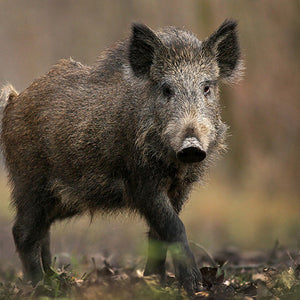The inspiration behind our new feral boar bar is as wild as the great state of Texas. This story is so rich and complex that we had to experience it first hand by immersing ourselves deep inside the Texas Hill Country for an EPIC hunt to harvest adventure that I will never forget. On this journey, we set out to explore the first hand effects of wild pigs and the myriad of consequences this invasive species has on land, native wildlife, the economy, and our food supply. In the spirit of being a "conscious carnivore" and "understanding the source of our food", we are excited to share with you an EPIC saga that covers the history of the invasive wild boar, our own hunt, and the reason why our newest EPIC bar is positively shaping our land.

It may come to surprise you that wild hogs are one of the most destructive and invasive species in the United States. Over two million of these pigs are wreaking havoc in over 39 states and 4 Canadian Provinces. In an article entitled "A Plague of Pigs in Texas", The Smithsonian reports that out of the $400 million in annual damages to land, agriculture, and wildlife, over half of these losses happen in Texas. Although wild pigs seem to thrive in any climate and condition, the lush, rolling Central Texas Hill Country is the perfect habitat for population expansion. As these wild animals become increasingly adapted to the human population, the incidences of urban destruction are on the rise. Wild pigs are responsible for destroying recreational areas, killing pets, and terrorizing tourists in state and national parks. On many of our camping trips in West Texas, Katie and I have come face to face with these powerful animals. As primarily a nocturnal eater, wild boar have raided our campsite at night, consumed our food, and caused damage to our property. On multiple accounts I have been woken late at night by the large teeth of a wild pig methodically tearing into our tent. For this reason, I now sleep with either a knife or tomahawk near my side.
From an economic perspective, these animals are known to destroy entire fields of sorghum, rice, wheat, soybeans, potatoes, melons and other fruits, nuts, grass and hay. These animals have an amazing sense of smell that results in pigs being able to extract recently planted seeds one by one. Asides from agricultural devastation, wild hogs till the soil and uproot many desirable native plants. This predisposes the earth to erosion, causes the loss of nutrient rich topsoil, and exposes delicate roots of heritage breed trees. This creates the perfect environment for invasive plants to move in and further disrupt native ecosystems. From a livestock perspective, these wild pigs consume the food farmers set out for their animals and when challenged will attack and eat the livestock itself. These opportunistic omnivores will also consume native wildlife such as deer, quail, bobcats, coyotes, and turtles.

The origins of these pigs are rooted deep into American history and can be traced back to domesticated hogs in rural economies. Pigs are not native to the Americas and were introduced hundreds of years ago by European pioneer settlers. In the last hundred years, many domesticated hogs were left to fend for themselves as the American population migrated towards cities and farms were left abandoned. As these pigs started breeding in the wild, they quickly developed characteristics that made them masterful omnivores who will eat just about anything. Through rapid breeding, escaped domestic hogs quickly adapted to the wild within months and become overwhelmingly resilient. It wasn’t until Eurasian wild boars were introduced into Texas (for hunting) in the 1930’s that further cross breeding and natural selection began to radically shift the behavior and anatomy of these rarely thought of animals. Starting in the 1980’s the wild hog population in Texas has exploded in ways that no-one could have predicted.
The rapid explosion of the feral hog population is a result of their remarkable ability to reproduce. Mother pigs begin breeding as early at 6 months of age and give birth to 16-24 piglets per year! These resilient animals have no predators, have an uncanny ability to evade hunters, and have developed thick protective bone plates that act as body armor.

The predominant solution to reducing the wild boar population in Texas is mass extermination through poison, aerial hunting, and trapping. Some counties are so desperate for help that they offer money to citizens who kill wild pigs! One of the most interesting economic opportunities to stem from this is the rise in professional hunters using helicopters. In some circumstances a single aerial hunter can kill up to 300 pigs with an assault rifle within a few hours. Although effective, this solution is not holistic as the carcasses of wild pigs are left out in fields to decay under the Texas sun.
When we first heard of these massive killings our natural thought was something along the lines of “I wonder what they do with all that healthy wild game meat?” The most disturbing conclusion was that in most cases, the meat is wasted and never consumed! This was the catalyst for us to find a creative way to convert these invasive and destructive animals into healthy and nourishing protein. Before we started, we set out on a hunt to harvest adventure to experience a wild boar hunt first hand… to be continued.




